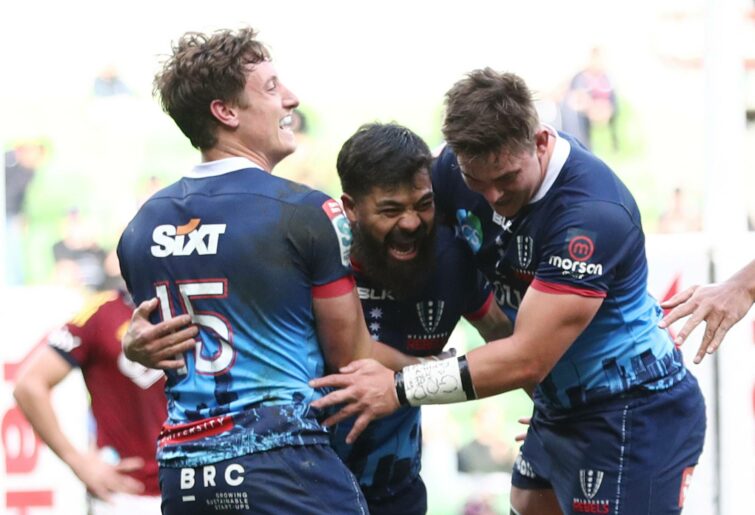It makes for a great headline, ‘Australia should chop the Rebels’, but the truth of the matter for Australian rugby is far more complicated than any one opinion piece could ever outline.
The New Zealand Herald opinion piece has been covered elsewhere on the site and was just too simplistic in its approach.
For one thing, it made no mention of the obvious loss of broadcast income on both sides of the ditch because of one fewer game every weekend. For another, the notion of “35 seasoned professionals” flooding into the other four teams is laughable for its miscalculation. French club squads north of 50 wouldn’t have 35 seasoned professionals.
But the major point it missed is that Australia needs its five teams right now because, in lieu of any other domestic competition, that’s the only opportunity for professional player development.
And yeah, there are significant flaws in this current approach, but it is the current approach nonetheless, and 150 professional contracts are clearly preferable to 120.
So, that’s a roundabout way of saying Hamish McLennan continues to drag Rugby Australia into the argument with New Zealand Rugby and trying to get a deal as close to broadcast funding parity because he feels he has to.
Of all the various ways RA can ‘just find more money’, the current broadcast deals are simply the first reigns available to be pulled.
The Australian states are desperate to have their pre-pandemic levels of annual funding restored, for obvious reasons, and RA is desperate to provide it simply because the battle to compete in the global rugby marketplace remains a losing one.
But in truth, Rugby Australia simply has more urgent priorities than they can afford.

(Photo by Mike Owen/Getty Images)
It urgently needs another tier of competition to bridge the increasing gulf between Super Rugby and the club game around the country. The desire is there, the need remains, but again, the states need the restoration of funding to be able to do it.
In its absence, the Australia A program made a welcome return this year and will undoubtedly want to be kept in some shape or form ahead of a Rugby World Cup next year. But is it sustainable?
Equally, as a governing body, RA really still hasn’t properly cashed in on the opportunity to further grow the game in new areas afforded by the women’s sevens gold medal in Rio de Janeiro – 2016 was six years ago.
It’s quite fortuitous that the Aussie women claimed the sevens triple crown and the men the World Series title this season as well, because it does renew the opportunity. Yet the sevens game remains chronically underdeveloped and underutilised across the country and especially through schools.
Considering how little sevens rugby is played in Australia, the titles won by both Australian outfits have been massively undervalued. It’s almost like the titles were won despite the attention given to the seven-a-side game.
And then there’s the Wallaroos and the Super W squads feeding into them. RA has stated its goal of 2025 to achieve full professionalism, but the current tournament has already shown a significant and increasing gap between the amateurs and the pros.
“I hope there are people at Rugby Australia – the CEO, Andy Marinos, and the chairman, Hamish McLennan – watching these women and going, ‘These could be our secret weapon’,” Sydney Morning Herald rugby correspondent Georgina Robinson concluded on The Roar Rugby Podcast this week.
“And then making a decision to put them higher up the list in funding priorities.”
And she’s spot on. RA cannot afford to be left sitting on its hands while other nations professionalise the women’s game, or it will suffer the twin humiliation of being woefully left behind in a rugby sense and completely plundered by the AFL and the NRL already ploughing their way to fully pro elite competitions.
I’ll just cut and paste the point I made a few weeks ago: by mid-next year, seven new NRLW teams will have come to life in three seasons. Who knows how many more it might be by 2025?
The Women’s Rugby World Cup in New Zealand currently has revealed a wonderful festival feel around games, a family-friendly environment that comes through the screen and pulls you in. It’s nothing like the unnecessarily aggressive, boozy blokes weekend feeling that seems so commonplace around the men’s game internationally.
Australian rugby needs to find a way to tap into that as well, but it’s debatable it can wait until hosting the 2029 tournament.
“The only people left slightly untapped to go after are women and families,” Georgina rightly stated.
Private equity remains the optimistic solution to all the current rugby problems in Australia and ideally the precursor to the hopeful golden geese of a British and Irish Lions tour and a couple of RWCs on home soil.
But the challenge remains extracting every fume skerrick from the decreasingly damp oily rag until then.
Never before has it been so important for Australian rugby to achieve so much with so little. The payday – or days, hopefully – may come, but that simply isn’t money that can be spent beforehand.
Hence, cutting a Super Rugby team right now really isn’t an option.
If the trans-Tasman status quo is to remain, then keeping five teams is the only way to ensure the maximum possible share of revenue from the current deals in the short term.
And that’s why McLennan keeps entering the fight that he really has no right to start but now can’t afford to lose.





























































































